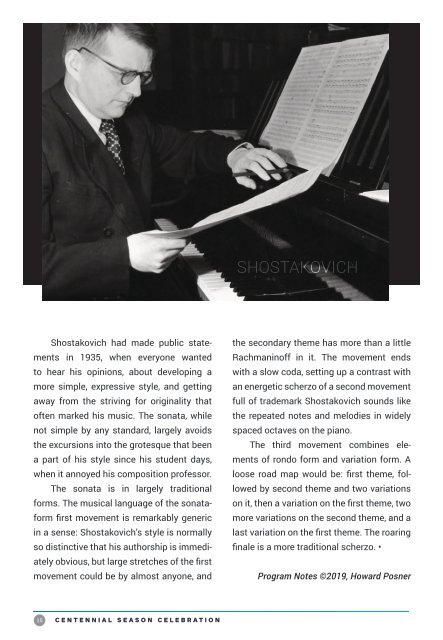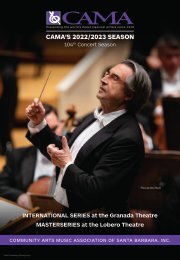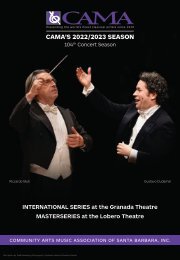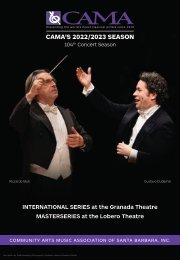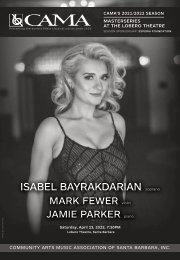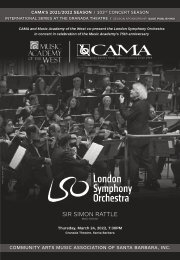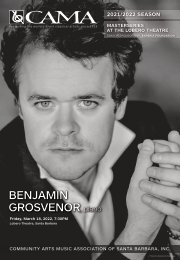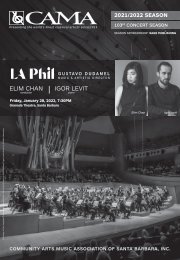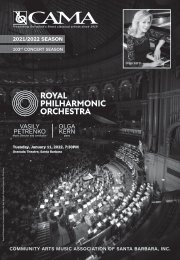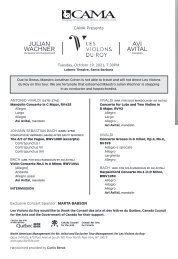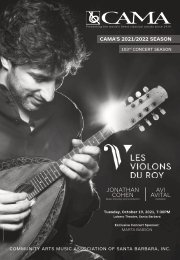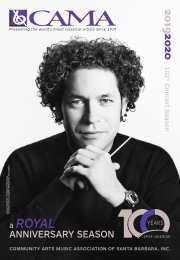May 6, 2019, Monday, 8:00 PM—Mischa Maisky, cello and Lily Maisky, piano—CAMA's Masterseries at The Lobero Theatre
MONDAY, MAY 6, 2019, 8:00 PM Mischa Maisky, cello Lily Maisky, piano Lauded by The Guardian for his “dazzling precision, fleet brilliance, and tender lyricism”, Latvian-born Israeli cello master Mischa Maisky is considered by many worldwide to be one of the handful of greatest living cellists. He has the distinction of being the only cellist in the world to have studied with both Mstislav Rostropovich and Gregor Piatigorsky and to carry on the deep musical legacy of these two great 20th Century Russian masters of the cello. His romantic emotion and absolute musical commitment carry the command of a true artist. It is fitting that Mischa Maisky will return by popular demand to the historic Lobero for the closing recital of CAMA’s historic 100th Concert Season. PROGRAM: Alessandro Marcello (arranged by J.S. Bach; and arranged for cello by Mischa Maisky): Movement II: Adagio, from Concerto in D minor, BWV 974 Johann Sebastian Bach (arr. S. Franco): Movement II: Largo, from Concerto for Harpsichord, Strings and Continuo No.5 in F minor, BWV 1056 Wolfgang Amadeus Mozart (arr. M. Maisky): Pamina’s Aria from The Magic Flute, K.620/Act II: “Ach ich fühl’s, es ist verschwunden” Johannes Brahms: Sonata No.2 in F major, Op.99 Pyotr Ilyich Tchaikovsky (arr. J. Stutschewsky and I. Thaler): No.10: October: “Autumn Song,” from The Seasons, Op.37a, TH 135 P.I. Tchaikovsky (arr. Viktor Kubatsky): No.6, “Valse Sentimentale,” from 6 Pieces, Op.51, TH 143 Dmitri Dmitriyevich Shostakovich: Sonata for Cello and Piano, Op.40
MONDAY, MAY 6, 2019, 8:00 PM
Mischa Maisky, cello
Lily Maisky, piano
Lauded by The Guardian for his “dazzling precision, fleet brilliance, and tender lyricism”, Latvian-born Israeli cello master Mischa Maisky is considered by many worldwide to be one of the handful of greatest living cellists. He has the distinction of being the only cellist in the world to have studied with both Mstislav Rostropovich and Gregor Piatigorsky and to carry on the deep musical legacy of these two great 20th Century Russian masters of the cello. His romantic emotion and absolute musical commitment carry the command of a true artist. It is fitting that Mischa Maisky will return by popular demand to the historic Lobero for the closing recital of CAMA’s historic 100th Concert Season.
PROGRAM:
Alessandro Marcello (arranged by J.S. Bach; and arranged for cello by Mischa Maisky): Movement II: Adagio, from Concerto in D minor, BWV 974
Johann Sebastian Bach (arr. S. Franco): Movement II: Largo, from Concerto for Harpsichord, Strings and Continuo No.5 in F minor, BWV 1056
Wolfgang Amadeus Mozart (arr. M. Maisky): Pamina’s Aria from The Magic Flute, K.620/Act II: “Ach ich fühl’s, es ist verschwunden”
Johannes Brahms: Sonata No.2 in F major, Op.99
Pyotr Ilyich Tchaikovsky (arr. J. Stutschewsky and I. Thaler): No.10: October: “Autumn Song,” from The Seasons, Op.37a, TH 135
P.I. Tchaikovsky (arr. Viktor Kubatsky): No.6, “Valse Sentimentale,” from 6 Pieces, Op.51, TH 143
Dmitri Dmitriyevich Shostakovich: Sonata for Cello and Piano, Op.40
- No tags were found...
You also want an ePaper? Increase the reach of your titles
YUMPU automatically turns print PDFs into web optimized ePapers that Google loves.
SHOSTAKOVICH<br />
Shostakovich had made public st<strong>at</strong>ements<br />
in 1935, when everyone wanted<br />
to hear his opinions, about developing a<br />
more simple, expressive style, <strong>and</strong> getting<br />
away from the striving for originality th<strong>at</strong><br />
often marked his music. <strong>The</strong> son<strong>at</strong>a, while<br />
not simple by any st<strong>and</strong>ard, largely avoids<br />
the excursions into the grotesque th<strong>at</strong> been<br />
a part of his style since his student days,<br />
when it annoyed his composition professor.<br />
<strong>The</strong> son<strong>at</strong>a is in largely traditional<br />
forms. <strong>The</strong> musical language of the son<strong>at</strong>aform<br />
first movement is remarkably generic<br />
in a sense: Shostakovich’s style is normally<br />
so distinctive th<strong>at</strong> his authorship is immedi<strong>at</strong>ely<br />
obvious, but large stretches of the first<br />
movement could be by almost anyone, <strong>and</strong><br />
the secondary theme has more than a little<br />
Rachmaninoff in it. <strong>The</strong> movement ends<br />
with a slow coda, setting up a contrast with<br />
an energetic scherzo of a second movement<br />
full of trademark Shostakovich sounds like<br />
the repe<strong>at</strong>ed notes <strong>and</strong> melodies in widely<br />
spaced octaves on the piano.<br />
<strong>The</strong> third movement combines elements<br />
of rondo form <strong>and</strong> vari<strong>at</strong>ion form. A<br />
loose road map would be: first theme, followed<br />
by second theme <strong>and</strong> two vari<strong>at</strong>ions<br />
on it, then a vari<strong>at</strong>ion on the first theme, two<br />
more vari<strong>at</strong>ions on the second theme, <strong>and</strong> a<br />
last vari<strong>at</strong>ion on the first theme. <strong>The</strong> roaring<br />
finale is a more traditional scherzo. •<br />
Program Notes ©<strong>2019</strong>, Howard Posner<br />
15 CENTENNIAL SEASON CELEBRATION


